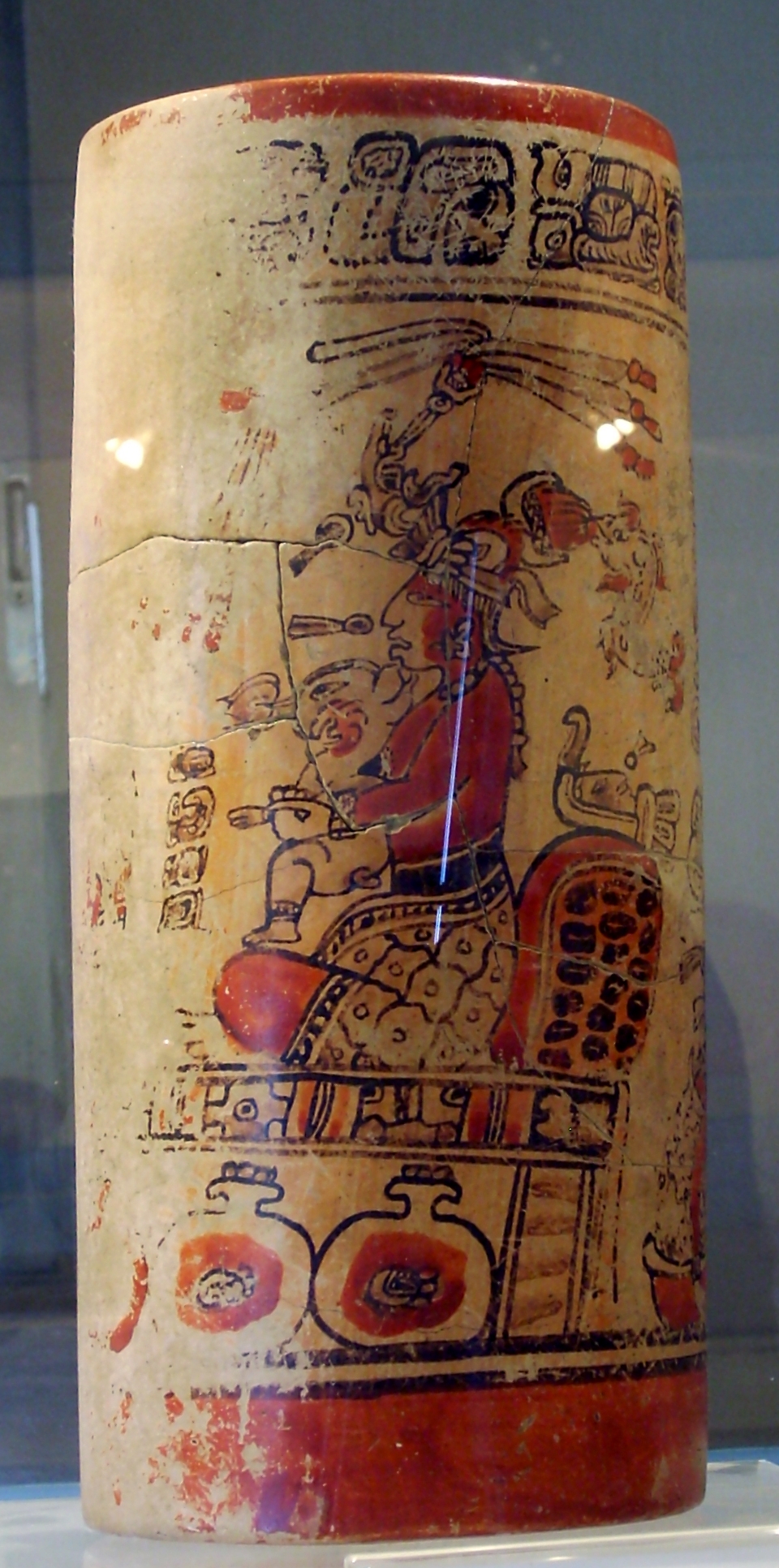|
Princeton Maya Vase With God L
The Princeton Vase is a noted example of Late Classic Maya ceramics in codex style. It was illegally looted and is now held by Princeton University Art Museum. Originally serving as a drinking vessel for chocolate, it depicts a throne room occupied by an aged deity, wearing an owl headdress, and by five young women surrounding him. In front of the throne, a bound captive is being decapitated by two masked men. This scene was long believed to refer to an episode in the Popol Vuh. The vase is said to be comparable to the Jaguar Baby vase in New York City's Metropolitan Museum of Art. Description The vase, with an overall cream and incidental orange and brown-black slip, as well as traces of post-fire Maya blue pigment, dates to the Late Classic period of Maya civilization (late 7th or early 8th century). It originated in the Nakbé region, Mirador Basin, Petén, Guatemala. A photograph of it was first published in M.D. Coe's ''The Maya Scribe and His World'' (1973). Toward the rim ... [...More Info...] [...Related Items...] OR: [Wikipedia] [Google] [Baidu] |
Maya Ceramics
Maya ceramics are ceramics produced in the Pre-Columbian Mayan civilization, Maya culture of Mesoamerica. The vessels used different colors, sizes, and had varied purposes. Vessels for the elite could be painted with very detailed scenes, while utilitarian vessels were undecorated or much simpler. Elite pottery, usually in the form of straight-sided beakers called "vases", used for drinking, was placed in burials, giving a number of survivals in good condition. Individual examples include the Princeton Vase and the Fenton Vase. Used for a plethora of daily activities, such as the storage of food and beverages, ceramics (art), ceramics were also a canvas of commemoration. There were three main types of ceramics used in daily life: bowls, plates, and cylinders. They were often monochrome, meaning that only one type of mineral slip was used. Polychrome pottery was more complex in nature and therefore more commonly used by the elite. Not only was polychrome pottery used as decoration ... [...More Info...] [...Related Items...] OR: [Wikipedia] [Google] [Baidu] |
Jaguar
The jaguar (''Panthera onca'') is a large felidae, cat species and the only extant taxon, living member of the genus ''Panthera'' that is native to the Americas. With a body length of up to and a weight of up to , it is the biggest cat species in the Americas and the List of largest cats, third largest in the world. Its distinctively marked Animal coat, coat features pale yellow to tan colored fur covered by spots that transition to Rosette (zoology), rosettes on the sides, although a melanistic black coat appears in some individuals. The jaguar's powerful bite allows it to pierce the Turtle shell#Carapace, carapaces of turtles and tortoises, and to employ an unusual killing method: it bites directly through the skull of mammalian prey between the ears to deliver a fatal blow to the brain. The modern jaguar's ancestors probably entered the Americas from Eurasia during the Early Pleistocene via the land bridge that once spanned the Bering Strait. Today, the jaguar's range ex ... [...More Info...] [...Related Items...] OR: [Wikipedia] [Google] [Baidu] |
Individual Pieces Of Pottery
An individual is one that exists as a distinct entity. Individuality (or self-hood) is the state or quality of living as an individual; particularly (in the case of humans) as a person unique from other people and possessing one's own needs or goals, rights and responsibilities. The concept of an individual features in many fields, including biology, law, and philosophy. Every individual contributes significantly to the growth of a civilization. Society is a multifaceted concept that is shaped and influenced by a wide range of different things, including human behaviors, attitudes, and ideas. The culture, morals, and beliefs of others as well as the general direction and trajectory of the society can all be influenced and shaped by an individual's activities. Etymology From the 15th century and earlier (and also today within the fields of statistics and metaphysics) ''individual'' meant " indivisible", typically describing any numerically singular thing, but sometimes meanin ... [...More Info...] [...Related Items...] OR: [Wikipedia] [Google] [Baidu] |
Pre-Columbian Pottery
In the history of the Americas, the pre-Columbian era, also known as the pre-contact era, or as the pre-Cabraline era specifically in Brazil, spans from the initial peopling of the Americas in the Upper Paleolithic to the onset of European colonization, which began with Christopher Columbus's voyage in 1492. This era encompasses the history of Indigenous cultures prior to significant European influence, which in some cases did not occur until decades or even centuries after Columbus's arrival. During the pre-Columbian era, many civilizations developed permanent settlements, cities, agricultural practices, civic and monumental architecture, major earthworks, and complex societal hierarchies. Some of these civilizations had declined by the time of the establishment of the first permanent European colonies, around the late 16th to early 17th centuries, and are known primarily through archaeological research of the Americas and oral histories. Other civilizations, contemporaneou ... [...More Info...] [...Related Items...] OR: [Wikipedia] [Google] [Baidu] |



